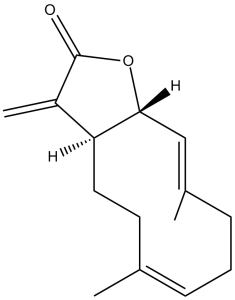This product is for research use only, not for human use. We do not sell to patients.

| Size | Price | Stock |
|---|---|---|
| 250mg | $900 | Check With Us |
| 500mg | $1450 | Check With Us |
| 1g | $2175 | Check With Us |
Cat #: V1388 CAS #: 553-21-9 Purity ≥ 98%
Description: Costunolide [also known as (+)-Costunolide, Costus lactone, CCRIS-6754 and NSC-106404] is a naturally occurring sesquiterpene compound with a wide spectrum of biological activities such as anti-inflammatory, anticancer, antidiabetic, antiviral, antimicrobial, antiulcer, antifungal, antioxidant, and anthelmintic properties.
Publications Citing InvivoChem Products
Product Promise

- Physicochemical and Storage Information
- Protocol
- Related Biological Data
- Stock Solution Preparation
- Quality Control Documentation
| Molecular Weight (MW) | 232.32 |
|---|---|
| Molecular Formula | C15H20O2 |
| CAS No. | 553-21-9 |
| Storage | -20℃ for 3 years in powder formr |
| -80℃ for 2 years in solvent | |
| Solubility In Vitro | DMSO: 47 mg/mL (202.3 mM)r |
| Water: <1 mg/mLr | |
| Ethanol: 1 mg/mL (4.3 mM) | |
| Solubility In Vivo | 2% DMSO+Corn oil: 10 mg/mL |
| Synonyms | Costus lactone; CCRIS 6754; NSC 106404; CCRIS-6754; NSC-106404; CCRIS6754; NSC106404; Costunolide; Costus lactone; (+)-Costunolide. |
| Protocol | In Vitro | Costunolide regulates c-Myc mediated apoptosis signaling and 14-3-3-mediated signaling pathways in breast cancer cells |
|---|---|---|
| In Vivo | Costunolide (20 mg/kg; i.p; daily; for 30 days) inhibits breast cancer through c-Myc/p53 and AKT/14-3-3 pathway | |
| Animal model | 4 weeks old female BALB/c nude mice, MDA-MB-231 cells xenograft mouse models | |
| Dosages | 20 mg/kg | |
| Administration | Intraperitoneal injection, daily, for 30 days |
| Solvent volume to be added | Mass (the weight of a compound) | |||
|---|---|---|---|---|
| Mother liquor concentration | 1mg | 5mg | 10mg | 20mg |
| 1mM | 4.3044 mL | 21.5220 mL | 43.0441 mL | 86.0882 mL |
| 5mM | 0.8609 mL | 4.3044 mL | 8.6088 mL | 17.2176 mL |
| 10mM | 0.4304 mL | 2.1522 mL | 4.3044 mL | 8.6088 mL |
| 20mM | 0.2152 mL | 1.0761 mL | 2.1522 mL | 4.3044 mL |
This equation is commonly abbreviated as: C1 V1 = C2 V2
- (1) Please be sure that the solution is clear before the addition of next solvent. Dissolution methods like vortex, ultrasound or warming and heat may be used to aid dissolving.
- (2) Be sure to add the solvent(s) in order.




































